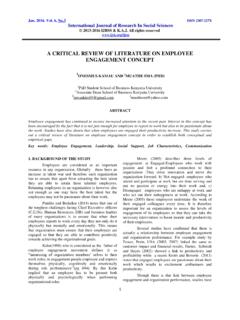Transcription of 2019 Saudi Arabia Healthcare Industry Overview
1 Together for a healthier world2019 Saudi Arabia Healthcare Industry OverviewA report by:Towards the Healthcare goals of Saudi Vision overviewSources: World Bank, WHO, KSA MoH, Colliers International, Knight FrankHealthcare remains a top priority for the government in the Kingdom of Saudi Arabia (KSA), and there are enormous opportunities for growth in this high-potential business line with the government s Vision 2030 and the National Transformation Program (NTP), the Ministry of Health (MoH) is expected to spend close to US$71 billion over five-years ending in 2020. According to US-based consultancy aon hewitt , the Healthcare sector in KSA is expected to grow at a compound annual growth rate of by 2020.
2 There is also a significant rise in population with an increase in those over the age of 60 years, as well as the adoption of mandatory health insurance in the increase efficiencies and reduce costs, the government in KSA has actively explored private sector involvement in the development of the Healthcare infrastructure in the Kingdom. By introducing Public-Private Participation (PPP) models for Healthcare , the government is working towards unlocking value in the health system and fast-tracking Healthcare reform with plans to increase private sector contribution in total Healthcare spending to 35% by , technology also remains a core factor in upgrading the KSA Healthcare sector in the coming years with information technology playing a pivotal role in offering solutions related to cost, quality, access and the availability of a skilled workforce in Healthcare is also emerging as a significant focus for the Kingdom.
3 Major efforts are underway to provide educational and training facilities for doctors, nurses and paramedics through the expansion of new medical line Healthcare stats for KSA In line with the government s Vision 2030 and the National Transformation Program (NTP), the Ministry of Health (MoH) is expected to spend close to US$71 billion over five-years ending in 2020. Million peopleby 2050 Government s vision 2030 and NTP focuses on Healthcare development13,700 doctors required by 203070% of population below the age of 40 of 2019 budget allocated to Healthcare 20,000 additional beds required by 2035 Life expectancy is expected to increase to (males) and (females) by 2050 Foreign investors can have 100% ownership in Healthcare sectorNCDs accounted for 68% of all deaths 295 hospitals and 2,259 Healthcare centres to be privatised by.
4 Healthcare In Saudi Arabia Opportunities In The Sector, May 2018, Knight FrankThe 2019 budget for healthcareIn a review of KSA s 2019 budget and recent economic developments, KPMG has highlighted that the Healthcare sector holds the third largest share of in the budget expenditure of 2019 . The budget allocation for the sector has grown by 8% to reach SAR172 billion in 2019 , as compared to SAR159 billion in 2018. Public spending on the Healthcare sector is largely channeled towards new initiatives, such as increasing the life expectancy, reducing obesity and localisation of pharmaceutical manufacturing. The government is also diverting the funds towards creating a robust Healthcare infrastructure by building new hospitals.
5 Saudi vision 2030 and the national transformation programHealthcare is one of the main focus areas of the Kingdom s Vision 2030 and the National Transformation Program. According to a report by Knight Frank, the main goal of the Vision 2030 is to diversify the economy away from hydrocarbons and achieve greater participation of the private sector by encouraging both local and international investments in several key industries such as Healthcare . Privatisation of government services is expected to help meet the goals set out in Vision 2030 to increase the private sector s contribution to GDP from 40% to 65% in NTP, which was developed to help fulfill the Vision 2030, has identified a number of key targets to be met by each government body by 2020.
6 The Kingdom s Healthcare plan under the NTP has placed the sector on a fast trajectory to privatisation and growth over the coming years. Privatisation is seen as a key focus area in the Saudi Vision 2030 and the NTP. As outlined by Knight Frank, the strategic objectives stated for Healthcare in the NTP include: Privatisation of one of the medical cities through a PPP scheme Increasing private sector share of spending in Healthcare through alternative financing methods and service providersNTP targets for the ministry of health for 2020 include: Increasing private Healthcare expenditure from 25% to 35% of total Healthcare expenditure Increasing the number of licensed medical facilities from 40 to 100 Increasing the number of internationally accredited hospitals Doubling the number of primary Healthcare visits per capita from two to four Decreasing the percentage of smoking and obesity incidence by 2% and 1% from baseline respectively Doubling the percentage of patients who receive Healthcare after critical care and long-term hospitalisation within four weeks from 25% to 50% Focusing on improving the quality of preventive and therapeutic Healthcare services.
7 Increasing focus on digital Healthcare innovationsSAR159billion in 2018 SAR172 billion in 2019100150200 Privatisation of one of the medical cities through a PPP schemeIncreasing private sector share of spending in Healthcare through alternative financing methods and service providers The government is also diverting the funds towards creating a robust Healthcare infrastructure by building new hospitals. & demandIn terms of supply, both private and public hospitals in KSA provide almost the same services; however, what differs is the capacity, quality, waiting time and most importantly, efficiency. As outlined in a recent research paper by Al Rajhi Capital, private hospitals provide a range of quality services to their patients including backup analytics, with a full medical experience but at a high cost.
8 The authors of the paper believe that this supply dynamics may change in the long run as the government is encouraging the private sector participation in the Healthcare sector as the public sector s role is gradually transitioned to becoming more of a regulator rather than as a provider of Healthcare facilities, as highlighted in the NTP and the privatisation plan. For Saudi citizens, the demand for Healthcare services through private hospitals focuses more on treating medical cases such as seasonal illnesses, minor fractures, delivery surgeries and cosmetic treatments, largely on the back of the pool of experienced doctors, coupled with lesser waiting time.
9 On the other hand, the importance of government hospitals is mostly for the treatment of severe medical conditions, for an example, Cancer, Internal Medicine and Ophthalmology. Nonetheless, those, who can afford the treatment, either cash or insurance coverage, prefer to go to private hospitals, the paper for bed spaceAccording to , the public sector dominates the supply of Healthcare services in KSA and accounts for the majority of Healthcare expenditures. The public Healthcare sector represents approximately 79% of bed capacity. Industry sources expect the private sector to grow at a faster pace than the government sector, enhanced by the latest government policies to encourage more private sector involvement in the provision of Healthcare , research from Knight Frank indicates that to keep pace with population growth, Saudi Arabia would require an additional 5,000 beds by 2020 and 20,000 beds by 2035, based on the current density of beds.
10 Based on the global average of bed density, Saudi Arabia faced a gap of 14,000 beds in 2016, and this gap is expected to widen to 40,000 beds by 2035. With life expectancy of both males and females on the increase, Colliers International expects this to create demand on long-term care (LTC) facilities, focusing on geriatric related care, rehabilitation and home Healthcare on current international benchmarks of 4-6 beds per 1,000 population above 65 years, Colliers International estimates that KSA currently needs between 6,400 - 9,600 beds dedicated for LTC. This is expected to reach 41,200 61,800 LTC beds by of hospitals27515845government ( )quasi Government ( )private ( )Source: MOH The public Healthcare sector represents approximately 79% of bed capacity.

